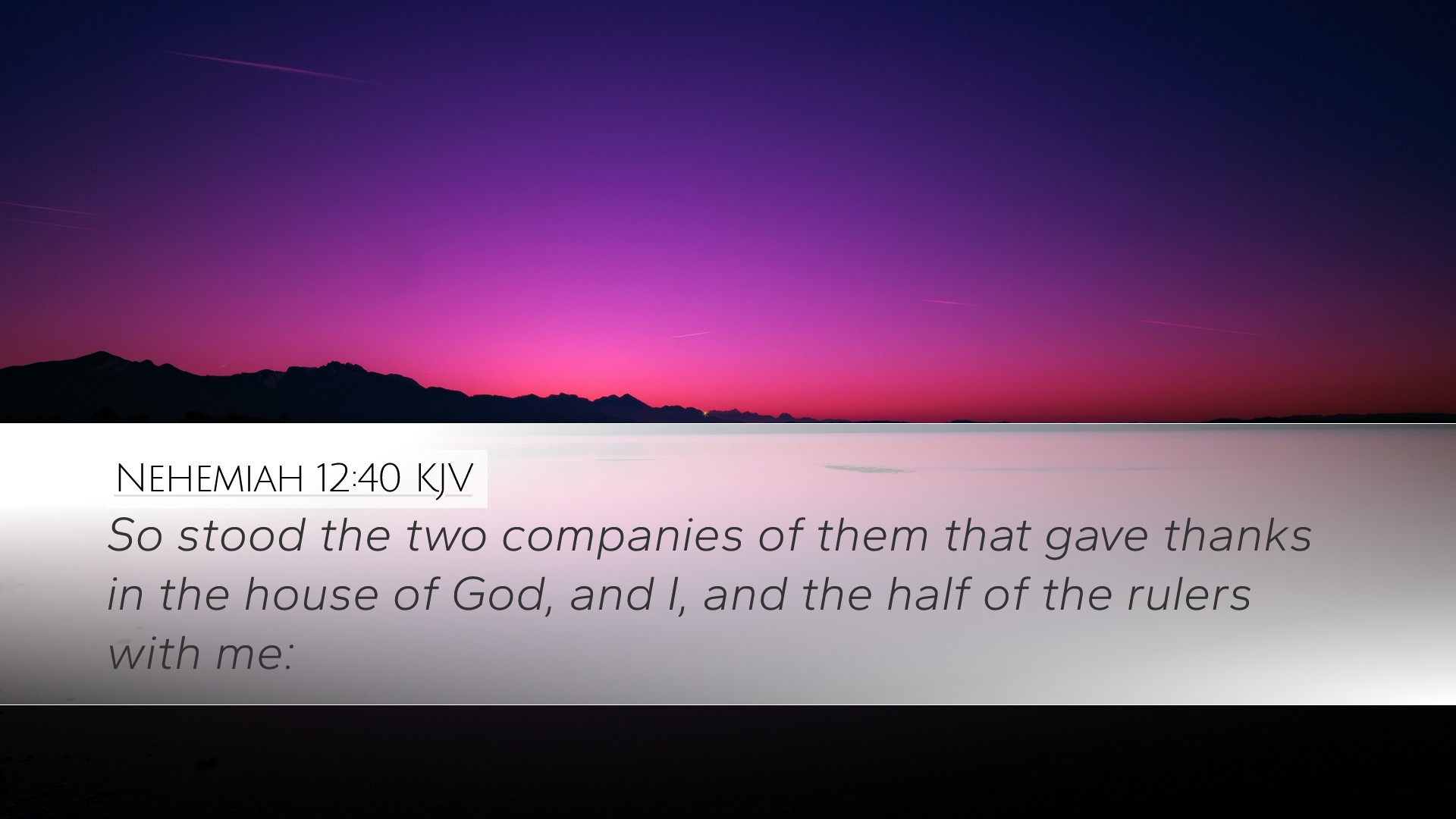Commentary on Nehemiah 12:40
Scriptural Reference: Nehemiah 12:40 - "So stood the two companies of them that gave thanks in the house of God, and I, and half of the rulers with me." (KJV)
Introduction
The verse of Nehemiah 12:40 encapsulates a significant moment in the history of Israel, showcasing the dedication and rejoicing of the people as they gather to worship God. This moment follows the completion of the wall around Jerusalem and emphasizes themes of community, worship, and thankfulness. In this commentary, we delve into the insights provided by notable public domain scholars such as Matthew Henry, Albert Barnes, and Adam Clarke, weaving their reflections together to deepen our understanding of the passage.
Contextual Background
The Book of Nehemiah details the return of the Israelites from Babylonian exile and their efforts to rebuild Jerusalem, particularly the walls that had been torn down. The completion of these fortifications signifies a restoration not only of physical structures but also of spiritual and communal identity. Nehemiah 12 captures a climactic celebration in the temple, where two choirs are appointed to give thanks, reflecting a united response to God’s faithfulness.
Analysis of Nehemiah 12:40
The Gathering of Two Choirs
Matthew Henry observes the significance of the two companies that stood to give thanks. He notes that their gathering in the temple symbolizes the congregation of God’s people. The act of standing illustrates their readiness to worship and honor the Lord collectively. This denotes not only a physical assembly but also a spiritual unity among the people, who come together to commemorate God's goodness and mercy.
The Role of Leaders
Albert Barnes highlights the involvement of Nehemiah and the rulers in this act of worship. The emphasis on leadership during this dedication is crucial because it illustrates that spiritual health and community worship begin at the top. Leaders set an example for congregational praise, signifying to the community that worship is a priority. The leadership's presence amidst the people serves to galvanize and encourage them to engage in thankfulness and reverence.
The Significance of Giving Thanks
Adam Clarke comments on the importance of giving thanks as a core aspect of worship. In this historical and theological context, thanksgiving is not merely an act of acknowledgment but a profound expression of faith. The act of giving thanks reflects recognition of God’s providence and a communal memory of His mighty deeds. Clarke emphasizes that such moments of gratitude are central to maintaining a robust and resilient faith community.
Theological Themes
1. Community Worship
The gathering of the people in Nehemiah 12:40 reveals the importance of communal worship in the life of believers. In the New Testament context, this alludes to the body of Christ coming together in unity, as seen in various passages throughout the epistles. Church leaders are encouraged to foster environments where collective worship can thrive, just as Nehemiah did.
2. Leadership and Responsibility
Spiritual leadership is crucial in guiding a community towards worship. As noted by Barnes, leaders in Nehemiah’s time took their responsibility seriously, indicating that effective leadership should inspire worship among the people. This theme resonates in past and contemporary church practices, highlighting the enduring role of leaders in congregational settings.
3. The Power of Thankfulness
Thankfulness is a recurring biblical theme, representing not just pleasantries but a fundamental attitude of the heart. Recognizing God’s past faithfulness fosters trust in His future provisions. Clarke emphasizes that such acts of gratitude serve not only to honor God but also to strengthen the faith of those who participate in them.
Practical Applications for Pastors and Theologians
Encouraging Community Engagement
Church leaders should prioritize creating opportunities for communal worship, reflecting the gathering depicted in Nehemiah 12:40. Encouraging congregations to participate actively in church life and worship can serve to unite believers and fortify their faith.
Modeling Leadership in Worship
The passage serves as a reminder for leaders to model what it means to worship authentically and wholeheartedly. By actively participating in worship alongside their congregations, leaders can foster an atmosphere of collective gratitude and reverence.
Harnessing the Impact of Thanksgiving
Embedding a culture of thankfulness within church programs and teachings can have lasting effects on congregational life. Incorporating regular thanksgiving services, testimonies, and reflections on God’s provision can enhance the community’s awareness of God’s faithfulness.
Conclusion
Nehemiah 12:40 showcases a pivotal moment of worship and community in the life of Israel. Through the analyses of prominent commentators, we see the significance of unity in worship, the role of leaders, and the essential practice of thanksgiving. As pastors, students, theologians, and Bible scholars reflect on this verse, it serves as a profound reminder of the importance of gathering together to honor God and acknowledge His mighty works in our lives.


